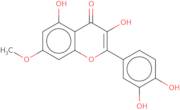
Información del producto
- 2-(3,4-Dihydroxyphenyl)-5,7-dihydroxy-y-methoxy-4H-1-benzopyran-4-oneRhamnetin3,3',4',5-Tetrahydroxy-7-methoxyflavone
- 2-(3,4-Dihydroxyphenyl)-3,5-dihydroxy-7-methoxy-4H-1-benzopyran-4-one
- 2-(3,4-Dihydroxyphenyl)-3,5-dihydroxy-7-methoxychromen-4-one
- 2-(3,4-dihydroxyphenyl)-3,5-dihydroxy-7-methoxy-4H-chromen-4-one
- 3,3′,4′,5-Tetrahydroxy-7-methoxyflavone
- 3,5,3′,4′-Tetrahydroxy-7-methoxyflavone
- 4H-1-Benzopyran-4-one, 2-(3,4-dihydroxyphenyl)-3,5-dihydroxy-7-methoxy-
- 7-Methoxyquercetin
- 7-Methylquercetin
- 7-O-Methylquercetin
- Ver más sinónimos
- Flavone, 3,3′,4′,5-tetrahydroxy-7-methoxy-
- Ly 805921
- NSC 19802
- Quercetin 7-methyl ether
- Rhamnetin
- β-Rhamnocitrin
- C.I. 75690
Quercetin is a flavonoid that belongs to the chemical class of polyphenols. It can be found in many plants, fruits, and vegetables. Quercetin has been shown to have anti-cancer properties in vitro assays and in vivo studies by inhibiting the proliferation of cancer cells. It also inhibits pro-inflammatory cytokines such as TNF-α. Quercetin has been shown to inhibit various enzyme activities, including those involved with hydrogen bonding interactions, cardiac effects, or natural compounds. The quercetin molecule contains a basic structure with six hydroxyl groups and three methoxy groups. One of these hydroxyl groups is esterified with an acetate group at position 3′ on the glucose ring (7-O-methyl quercetin). This esterification makes quercetin more lipophilic and increases its membrane permeability. 7-O-Methyl quercetin has been found to have anticancer
Propiedades químicas
Consulta técnica sobre: 3D-FM25558 7-O-Methyl quercetin
Si desea solicitar un presupuesto o realizar un pedido, por favor añada los productos deseados a su carrito y solicite un presupuesto o pedido desde el carrito. Es más rápido, más barato, y podrá beneficiarse de los descuentos y las ventajas disponibles.





